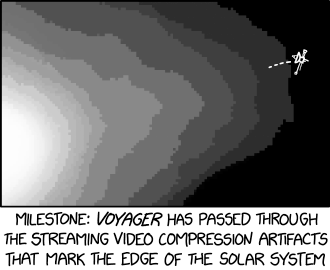Solar System Compression Artifacts

Most of our universe consists of dark matter rendered completely undetectable by our spacetime codec's dynamic range issues.

Most of our universe consists of dark matter rendered completely undetectable by our spacetime codec's dynamic range issues.
Voyager 1 is a space probe launched by the United States in 1977. Originally designed to study the outer planets of the Solar System, it is now several decades into an extended mission beyond Neptune (see #Trivia). The Voyager probe has made history for passing many milestones of our solar system.
When images are compressed by a lossy compression format (e.g. JPEG), visual artifacts are created. Randall here is suggesting that the probe has passed the artifacts as if the artifacts were an actual feature of the solar system rather than a consequence of our technology. The banding lines he has drawn are commonly seen in old images with low bit depth.
The 'solar system' in the snapshot appears to be a 4-bit greyscale-plane at a more pixelated level than the image given. It contains 16 'banded' levels from the brightest (closest zones, within this image, to the Sun) to darkest (the furthest illustrated expanses, including interstellar space), with irregular or non-trivial transitional edges but no obvious or dominant dithering/speckling or 'noise'. The Voyager image (and track) is overlaid in a white 'line drawing' format.
Each apparent pixel in this low-res rendering is approximately 1 AU², where 1 AU (astronomical unit) is the distance from the Sun to the earth. The Sun is off the left side of the image by about 30 pixels, meaning that of all the planets in the solar system, only Neptune would have an orbit that is within the image at all (at the left edge). The heliosphere is 120 AU from the sun, in the direction that Voyager 1 is travelling: Voyager crossed that milestone in August 2012. At time of publication Voyager was just over 150 AU from the Sun, as shown in the image.
Continuing on its course at 38,000 mph, or 3.6 AU/year, Voyager will reach the outer edge of the Oort cloud, the edge of our solar system, in about 300 years.
The title text refers to 'our spacetime codec', suggesting a representation of reality itself as a series of ones and zeros. If empty space is the darkest possible thing that can be represented--which may be the case when only 16 levels are available (see above)--then it is possible that dark matter is so dark that it cannot be represented: it would require a negative number, which is not available. This is the dynamic range issue mentioned.
The title text may also be a pun on the term "Render", as the codec's issues would both make cause the dark matter to be undetectable and, in the metaphor of the universe as a simulation, literally fail to render the "pixels" in the dark matter. This is the play on the term "Render" having multiple definitions, both meaning "To cause to become" and being the term in computing for "Transforming (a model) into a display on the screen or other media", as per Wikitionary.
Artefacts are evident in 1683: Digital Data, and mentioned in the title text of 331: Photoshops.